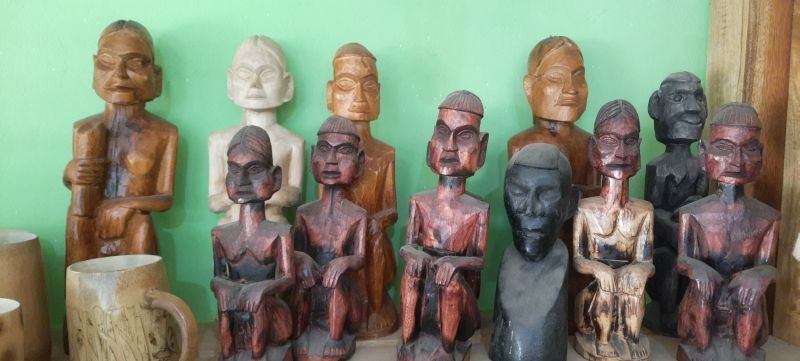
A panoramic view on Diezephe village of Dimapur
Handlooms and Handicrafts is a non-farm sector in rural India representing the culture, heritage of the country. This sector of industry passed on from generation to generation as a legacy. It is an economic form and went on to become an alternative livelihood for the farmers and rural people. It is very important and its contribution towards the rural economy of India is increasing steadily. Since, India is an agriculture-based country where 700-million (around 70%) strong rural population are living in about 600,000 small villages; there is a wide scope of cottage industry in India. The most advantageous aspect of this sector of economic production is its utmost utilisation of home-based labour with low capital investment ventures.
Presently, India's share in the global market stands at 2% only. However, the handicraft industries in rural India economy registered an annual growth rate of 15% consistently over the last decade and it is estimated to grow at the rate of 42% over the next five years annually.
Nagaland, the 16th state of India inaugurated on 1st Dec. 1963 is very rich in Handloom & Handicrafts as it has been traditionally practiced in each and every household of the state. The people of the state have perfected the art of creating several products through available resources from the farms, fields, and forests. The Diezephe village of Chümoukedima district is one of the finest examples. The village is also known as craft village of Nagaland. The Village was first established in 1976 and a small church was built but they were driven away for some reasons. It was reoccupied in 1978 and later in 1983. It was officially recognized by the Government in 1992 and in 2000, it got designated as a Craft Village. At present, the village has a household of around 250 families with a population of more than 1000. The major tribes inhabiting the village are Chakhesang (60-65%), Angami (30%), Ao (4-5%), Rengma, Lotha and Mao (2-3%).
The chief occupation of the villagers is craftworks (handicraft and weaving) followed by agriculture. The people are known for their excellent craftsmanship. Agriculture is mostly done by the hired workers from Assam. The different craft units in the village functions under a common community workshop scheme entitled the Craft and Development Society. There is also training programme conducted regularly by the State govt. to empower the youth for 20-30 days.
While having a field survey into the village the authors have an interaction with Velasuzo Shizo, proprietor of one of the major craft unit in the village. The 69 year old has served as the Village Chairman for 10 years and later as a Youth Director in the local Church for another 10 years. He started his work in handicrafts 23 years ago in order to support himself. Later, at the age of 60, he decided to train his own children in the craft so that they could have a more sustainable future. Although, academically he wasn’t quite successful, he gradually mastered the craft and gained popularity. His work was recognized by the Government of Nagaland and he was awarded the Governor’s Award for Handicrafts in the year 2010. He underwent 4 month training on craftworks in Saharanpur, U.P but later, realized that the craftworks in U.P had nothing in common with those in Nagaland. Therefore, most of his skills in craftwork had been gained through his own experience and practical knowledge.
He produces around 80-90 different items- varieties of mugs, spoons, forks, spatulas, plates, key-chains, trays, bowls, decorative items, souvenirs etc. The most popular item is the wooden mortar and pestle followed by the wooden plate. The price range of the items varies from Rs.30 for a keychain to Rs.3500-4000 for a large traditional wooden tray. Besides local markets in the state, the items are in huge demand in other states such as Arunachal Pradesh, Senapati (Manipur), Guwahati and even Delhi.
Modes of production:
• The craftsmen employed in the industry are Nagas, both men and women. While the men carves the items, women gives the finishing touches.
• The employees are given a weekly payment depending on the number of items they have produced.
• The profit consisting of 20% to 25% which is a good earning according to him (e.g for a wooden cup costing Rs.150, he has to spend around Rs.100-120).
• Raw Materials- The chief raw material used is teak wood as it grows well in warmer climates and hence, is locally available. They are mostly procured from Jalukie and Intangki. Gamari wood is also obtained from Diphu in Assam.
• Tools used are machines as well as handy tools like the chisel.
• The difference between the bamboo crafts from Assam and the wooden crafts from Diezephe is their production and durability. For instance, the use of adhesives like Fevicol at the base of a wooden mortar prevents it from cracking and also gives a firm grip on the floor.
• The advantage of using wood instead of metal for production is that it is more eco-friendly and also reduces noise pollution which is usually created while using metal utensils or products. As such, wooden products are more in demand in the market.
SUSTAINABILITY: Velasuzo makes an annual income of 15-16 lakhs approximately from his craft works alone. In order to feed a huge family of seven children, he depends on agriculture for his staple diet which is rice. The rest of his expenses including the education of his children are fulfilled by his income from the handicraft works.
ADVICE TO YOUNGSTERS: With the unemployment problem on the rise, one should not rely on Government jobs alone. Rather, youngsters should find ways and means to be self- sufficient. Instead of seeking for employment in some unfamiliar metropolitan cities, it is better to establish oneself locally and support local business which will protect the Naga heritage as well.
Article contributed by Mukutar R Saikia & Nungshilemla Kichu, Asst Professors, Department of History, St John College, Dimapur




